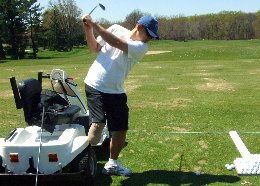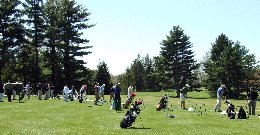
Army Sgt. 1st Class David Cook, from Westchester, Ill., keeps his balance as he swings a six-iron during the "First Swing" Golf Seminar held April 20 at Woodmont Country Club in Rockville, Md. Cook was one of 10 amputee outpatients from Walter Reed Army Medical Center, in Washington, D.C., who attended the event sponsored by Eastern Amputee Golf Association in conjunction with Disabled Sports USA. Photo by Petty Officer 2nd Class Molly Burgess, USN
|

Disabled veterans hit golf balls during the "First Swing" Golf Seminar on April 20 at Woodmont Country Club in Rockville, Md. Eastern Amputee Golf Association, sponsored the seminar in conjunction with Disabled Sports USA, and offered wounded warriors a chance to learn about adaptive golf equipment and enjoy an afternoon on the links. Photo by Petty Officer 2nd Class Molly Burgess, USN
|
|
ROCKVILLE, Md., April 22, 2007 - In golf jargon, a “handicap” refers to the number of strokes that separates an amateur golfer from a pro. On the Woodmont Country Club driving range here April 20, the term described a more literal disadvantage.
“It’s just an obstacle,” said Tom Willard, a novelist and a former Army paratrooper in the 101st Airborne Division whose left arm was amputated after he was shot five times in Vietnam. With the aid of the “Amputee Golf Grip,” a prosthetic device Willard invented, he has continued driving, pitching and putting through the years.
“You can go over the obstacle, under it, around it or through it,” he said. “And ‘through’ is the best way to go.”
Several disabled golf instructors like Willard joined Disabled Sports USA with its partner program Wounded Warrior Disabled Sports Project in offering 10 wounded servicemembers from Walter Reed Army Medical Center, in Washington, D.C., the “First Swing” golf seminar here. In 2007, the partnered programs will sponsor more than 70 events in 19 different sports in 14 states.
“There is no tool better than sports to get people active again, self-confident again and to believe in themselves again after they’ve become disabled,” said Kirk M. Bauer, executive director of Disabled Sports USA, who lost his leg in Vietnam when a grenade detonated nearby.
“(Wounded servicemembers) teach all of us that no matter what life throws at you, if you’ve got the right opportunities and the right attitude, you can overcome that and go on and lead a very active and a very successful life,” he said. “But you have to move forward, and you have to believe in yourself. That’s what they’re teaching all of us.”
In the country club ballroom, wounded vets listened as Bob Buck, the executive director of Eastern Amputee Golf Association, explained various prosthetic golfing devices and adaptive equipment. He suggested putter extensions for above-knee amputees who have difficulty bending over, specially-designed gloves for golfers with hand injuries, and clubs with swiveling heads that allow a golfer to swing from a seated position if necessary.
Buck said the Eastern Amputee Golf Association has a 3,000-person mailing list that includes 1,100 amputees, sponsors eight 36-hole tournaments, conducts golf clinics around the country, and currently gives 18 scholarships to amputee servicemembers or their children. Through a donation by Buck’s associate, Don Boyd, each of the wounded vets would receive a set of clubs as a parting gift and as incentive to keep swinging.
Having received a prosthetic right leg in 1970 after a car accident, Buck is proof that amputee golfers can excel on the links. “I was about a 12 handicap before I lost my leg at age 28, and I’ve been as low as a four since then. My swing has probably improved,” he said.
Army Sgt. 1st Class David Cook, from Westchester, Ill., said he was excited to try golfing for the first time since his right leg was amputated below the knee five weeks ago. Sitting in a wheelchair with his amputation site wrapped in a bandage, Cook had set his sights low.
“I wish I had my prosthetic so I could stand up and hit the ball,” Cook said. “I’m just looking forward to getting back out there. Realistically, I’m not going to be able to hit the ball since I don’t have the other foot yet.”
“You’ll be surprised,” Buck interjected.
In a convoy of golf carts, the disabled veterans and their instructors wheeled around freshly cut fairways, and onto the driving range that overlooked a lightly down-sloping pitch. During the sunny afternoon, flags indicating various distances downrange flapped in the breeze.
Cook drove his “Golf Xpress” single-rider cart to a spot on the range next to a shiny pyramid of golf balls, and then rotated his seat 90 degrees to face the stack. Rising from the seat, Cook hopped on his left foot and used a six-iron to fish a ball from the top of the pyramid. Then he hopped into swinging position.
“I’ve never done this before,” he said, still hopping. Balancing himself, Cook began his backswing. His club shaft was nearly parallel to the ground before he drove the iron toward the ball.
Upon contact, a large earthy divot flew almost as far as the ball. Then Cook launched a low line drive that hooked into the trees just off the fairway for his second shot.
On his third swing, Cook hit a picture-perfect iron shot that sailed straight down the range and rolled near the black-and-white checkered flag marking 120 yards.
“Now I liked that one,” Cook said after firing off an equally clean drive that breezed well past the checkered flag. “I could do this every day.”
Willard took a break from instructing to sneak in a few shots using a six-iron he gripped with his prosthetic device. He then stepped back and observed the other golfers’ progress. “It’s not here or here that’s important,” Willard said, pointing to his arm then to his leg.
Motioning towards his heart, he said, “It’s about what’s in here.”
|